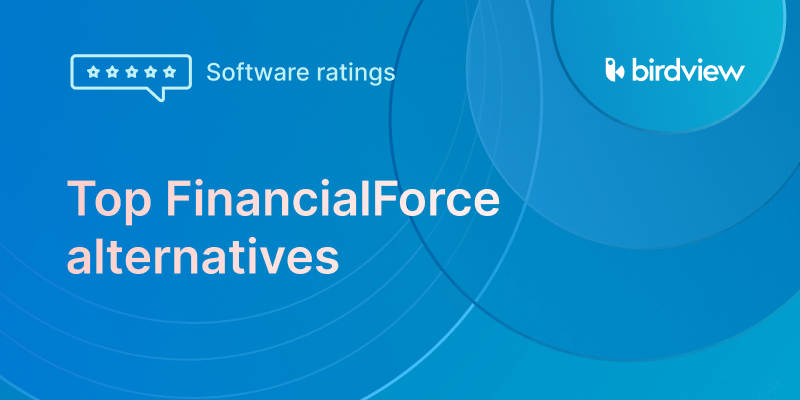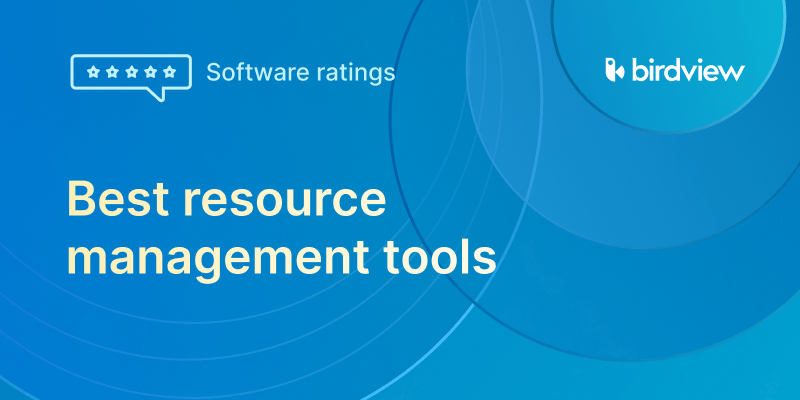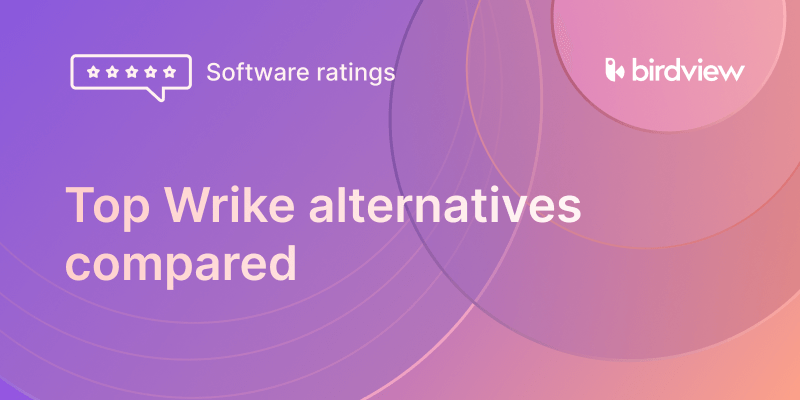Running an ad agency means juggling a lot more than creative ideas and client pitches. You’re coordinating remote teams across time zones and managing overlapping campaigns for multiple clients. The right software does more than help. It makes delivery scalable and predictable.
So what should you actually look for? We focused on a few things: scalability (because agencies grow and shrink), integrations (your tools need to talk to each other), ease of use (if onboarding takes a month, it’s already a problem), cost-effectiveness, and features that actually matter to agencies.
PSA first: what this guide covers
Advertising agencies use two different categories of software. Adtech runs campaigns and optimizes media. Agency operations software (Professional Services Automation, or PSA) runs the business behind the work: projects, resources, time, budgets, and reporting in one system. This guide focuses on PSA for agencies and how it beats a stack of disconnected apps.
What to look for in agency PSA:
- Scalability. Agencies expand and contract. Your platform should handle both.
- Integrations. Outlook or Google, CRM such as Salesforce or HubSpot, Adobe Creative Cloud, and accounting such as QuickBooks or Xero. Fewer manual updates mean fewer errors.
- Ease of use and adoption. Training should fit into delivery, not stall it.
- Financials. Rate cards, retainers, WIP, change orders, revenue forecasting.
- Reporting. Real-time utilization, profitability, and portfolio health.
PSA vs ad management: pick the right category
PSA (run the agency): scopes, timelines, resource plans, rate cards, retainers, time and expenses, invoicing, portfolio reporting. Ad management (run the ads): channels, budgets, bidding, creative testing, media performance dashboards.
If your priorities are margins, capacity, and predictability across clients, start with PSA. If you only need to automate media buying, choose ad management.
Project management and resource planning software
Good project management software is the backbone of any agency. It’s where chaos either gets organized or spirals out of control.
Birdview PSA – best for full-service advertising and creative teams
Birdview is purpose-built for advertising agencies, and it shows. It handles the full lifecycle of a campaign, from the initial brief and media planning through production, delivery, and post-mortems. What sets it apart is how it manages resources: you can see who’s overloaded, who’s got bandwidth, and where bottlenecks are forming before they become problems. For agencies running multiple campaigns at once (which is basically all of them), that visibility is everything. Birdview has also been featured in various reports as the best advertising agency software by SoftwareAdvice and Capterra.
Key features:
- Full campaign lifecycle management from brief to delivery
Track every stage of your campaigns in one place, from the initial client brief through creative development, approvals, production, and final delivery
- Resource capacity planning and workload visualization
See who’s available, who’s overbooked, and where you have capacity gaps so you can assign work strategically and avoid burnout
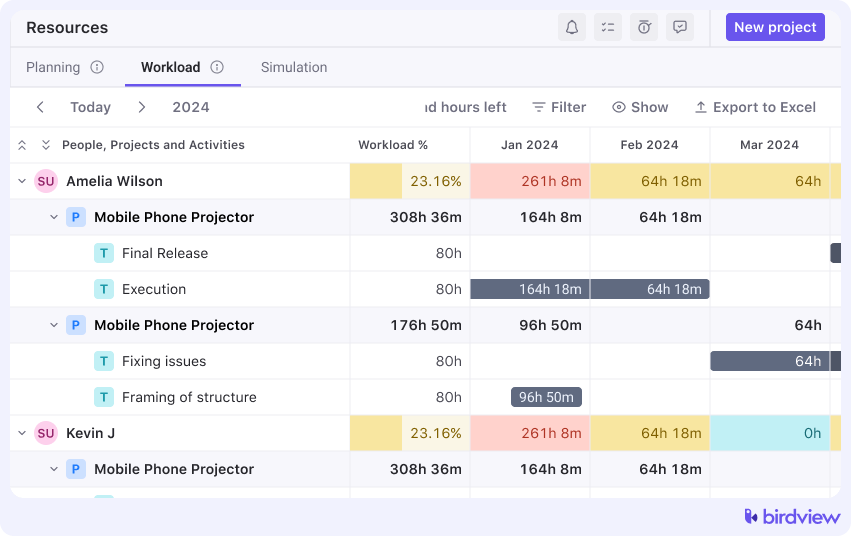
- Time tracking integrated with project tasks
Log hours directly within tasks and projects, making it easy to track billable time without switching between tools
- Built-in billing and invoicing
Generate invoices based on tracked time and project budgets, eliminating the need for separate accounting software
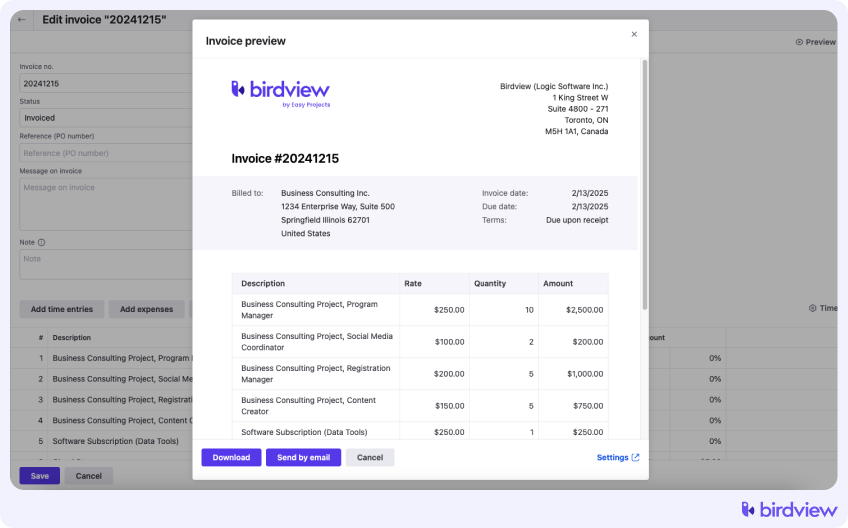
- Client portals for transparency and collaboration
Give clients secure access to view project status, timelines, deliverables, and updates without cluttering internal workflows
- Reporting and analytics dashboards
Get real-time insights into project profitability, team utilization, budget burn rates, and campaign performance with customizable reports
- Integrations for agencies:
Birdview PSA integrates with 5000+ tools and application. Microsoft 365 or Outlook, Google Workspace, Slack or Teams, Salesforce or HubSpot, Adobe Creative Cloud, and accounting such as QuickBooks or Xero.
Trial: A free 14-day trial is available, with the possibility of extending to 28 days.
What users like: Resource management capabilities get consistent praise. Users appreciate being able to see team capacity at a glance and avoid overloading people. The flexibility to customize workflows without a developer is another plus, and teams report fewer tool switches because more work stays in one platform.
What users dislike: The learning curve can be steep initially, especially for smaller teams used to simpler tools. Some users find the interface could be more intuitive, and a few mention that setting up integrations takes more effort than expected.
Workzone – best for small to mid-sized teams
Workzone is another solid option, especially if you want something straightforward without a steep learning curve. It’s less flashy than some competitors, but that’s kind of the point. Teams can hit the ground running with it. Task management is clean, timelines are easy to visualize, and it handles file sharing and approvals without unnecessary complexity.
Key features: Task management with templates, Gantt charts, and timelines, file sharing and version control, approval workflows, workload management, custom reporting, and email-to-task conversion
Trial: Free trial available (request through their website)
What users like: The simplicity is what people mention most. It’s intuitive enough that new team members can start using it without extensive training. Users also appreciate that it doesn’t try to do too much, focusing instead on doing core project management really well.
What users dislike: It lacks some of the advanced features that larger agencies might want, like detailed resource forecasting or complex budget tracking. The mobile app isn’t as robust as the desktop version. Some users wish there were more integrations with other marketing tools.
Collaboration and communication tools
Slack – best for fast-paced team communication
Slack has become the default for a reason. Channels let you organize conversations by client or campaign, so everything related to a project lives in one place instead of being scattered across inboxes. Integrations are where it shines. Connect it to your project management tool, file storage, and calendar, and updates start to flow automatically. It pairs well with a PSA backbone to keep delivery, time, and budgets aligned.
Key features: Organized channels by project/client, direct and group messaging, file sharing with searchable history, thousands of app integrations, video and voice calls, workflow automation, mobile apps
Trial: Free plan available with limited features; paid plans offer free trial
What users like: The organization by channels keeps conversations focused and easy to find later. Integrations mean less context switching between apps. The informal, chat-based format also tends to feel less rigid than email, which can speed up decision-making.
What users dislike: It can become overwhelming with notifications if not managed well. Some teams find that important information gets lost in busy channels. The free version has message history limits that can be frustrating.
Microsoft Teams – best for agencies already using Microsoft 365
If your agency already lives in the Microsoft ecosystem, Teams might make more sense. It’s tightly integrated with Office 365, so documents, meetings, and chats all exist in the same environment. For some teams, that’s a dealbreaker advantage.
Key features: Chat channels and messaging, video conferencing (up to 300 participants), deep Microsoft 365 integration, file collaboration with co-editing, task management via Planner, third-party app integrations
Trial: Free version available; paid plans through Microsoft 365 subscriptions (often with trial periods)
What users like: If you’re already using Outlook, OneDrive, and other Microsoft products, everything works together seamlessly. The video conferencing is reliable and doesn’t require additional software. Document collaboration is smooth since everything’s in the same ecosystem.
What users dislike: The interface isn’t as clean or intuitive as Slack’s. Finding specific features can be confusing because there’s so much packed into one platform. Some users find it feels more corporate and formal compared to Slack. Performance can be sluggish, especially with lots of apps and integrations running.
Creative brainstorming and design tools
Miro – best for visual brainstorming and remote collaboration
Miro is a digital whiteboard that actually works. Brainstorming sessions, mood boards, and campaign mapping are all covered. The big benefit is how it lets remote teams collaborate in real time without the awkwardness of constant screen sharing. It pairs well with a PSA backbone to turn workshop outcomes into staffed tasks and timelines.
Key features: Infinite canvas for visual collaboration, pre-built templates for workshops and planning, real-time collaboration with multiple cursors, sticky notes, and diagrams, built-in video chat and commenting, integrations with Slack/Teams/Jira, and presentation mode
Trial: Free plan available with limited boards; paid plans offer a free trial
What users like: Real-time collaboration feels natural, almost like being in the same room with a physical whiteboard. The template library saves time on common workflows. It’s also great for async work since team members can contribute whenever, and others can see the updates.
What users dislike: The infinite canvas can be overwhelming at first, and boards can get messy without good organization. Some users find the free version too limited for regular use. Performance can lag with very large, complex boards.
Figma – best for collaborative UI/UX design and prototyping
Figma has basically taken over for design collaboration, and if you’re doing any kind of digital work, you’re probably already using it. Real-time editing means multiple people can work on the same file without version control nightmares.
Key features: Browser-based design tool (no installation needed), real-time multiplayer editing, prototyping and interactive mockups, design systems and component libraries, developer handoff with code generation
Trial: Free plan for individuals; paid plans offer a free trial for teams
What users like: The real-time collaboration changes how design teams work–no more passing files back and forth or dealing with version conflicts. Being browser-based means anyone can access it from anywhere without installation headaches.
What users dislike: It requires a stable internet connection since it’s cloud-based. Some users with Adobe backgrounds find the transition awkward at first. The free version limits the number of files and projects. Advanced features like variables and complex prototyping have a steeper learning curve.
Proofing and feedback software
Ziflow – best for managing complex approval workflows
Ziflow solves this by centralizing feedback in one place. You upload a design, video, or document, share a link, and stakeholders can leave timestamped or pinned comments directly on the file. No more “I think it was on slide 3, or maybe 4?” confusion.
Key features: Visual annotation and markup tools, side-by-side version comparison, automated approval workflows, integrations with project management and creative tools, time-stamped comments for video, and customizable review stages
Trial: Free trial available (14 days)
What users like: The centralized feedback eliminates email chaos and scattered comments. Version control is automatic, so everyone’s always looking at the current iteration. Approval workflows can be customized to match how your agency actually operates.
What users dislike: Pricing can get expensive as your team grows. Some users find the interface cluttered with too many options. Getting clients to use the platform instead of defaulting to email can be a challenge initially. A few mention that customer support response times vary.
ReviewStudio – best for frame-accurate video and animation feedback
ReviewStudio takes a similar approach but with a focus on video and animation. Frame-accurate comments mean feedback is specific, not vague. If you’re doing a lot of motion work, like social ads, explainer videos, that kind of thing, this is built for exactly that.
Key features: Frame-accurate video review and annotation, support for video/images/PDFs/audio, real-time collaboration on reviews, version control and comparison, customizable approval workflows
Trial: Free trial available (14 days)
What users like: The interface is cleaner and more intuitive than some competitors. Pricing is more reasonable for smaller agencies and freelancers. The version comparison feature makes it easy to show clients exactly what changed.
What users dislike: It has fewer integrations compared to more established platforms. Some advanced features that larger agencies need might be missing. The mobile experience isn’t as polished as the desktop version. A few users mention occasional performance issues with very large video files.
How to choose the right stack
There’s no universal answer here because every agency is different. A five-person boutique shop doesn’t need the same setup as a 50-person full-service agency. Start by asking a few questions.
- How big is your team, and where are they working? If everyone’s in the same office, some tools matter less. If you’ve got freelancers in three countries, collaboration and communication tools move up the priority list.
- What’s your budget? Some of these tools scale with team size, others charge per feature. You don’t need to adopt everything at once. Start with the essentials, like project management and communication, and layer in more advanced tools as you grow.
- What are your integration needs? If your team already uses specific software for billing, CRM, or analytics, make sure your new tools play nice with them. A disconnected stack creates more problems than it solves.
- How important is data security and client confidentiality? Some industries have stricter requirements. Make sure whatever you choose meets those standards.
And here’s something people don’t talk about enough: adoption matters more than features. The fanciest tool in the world is useless if your team won’t actually use it. Plan for training. Get buy-in early. Revisit your choices after a few months to see what’s working and what’s collecting dust.
Wrapping up
The right tools help you move faster, communicate better, and deliver higher-quality work without burning out your team. They also make scaling possible, whether that means taking on more clients, expanding your services, or just getting through Q4 without everything falling apart.
The key is finding what actually works for your agency, not just what’s popular. Test things out. Most of these tools offer free trials or demo periods. Customize your setup to match how your team actually operates, not how some ideal agency is supposed to work.
Which stack fits your agency? The only way to know is to try. Start by exploring Birdview PSA for your agency‘s project management needs.

